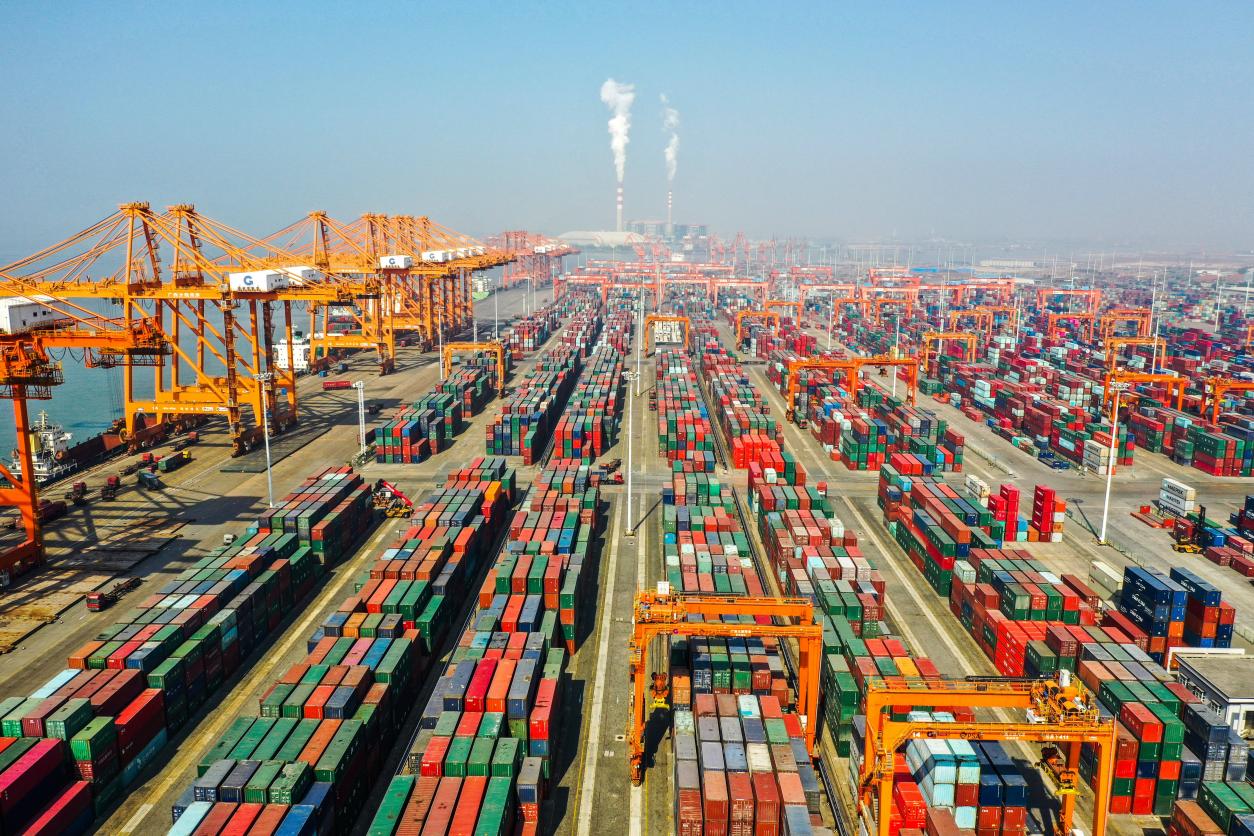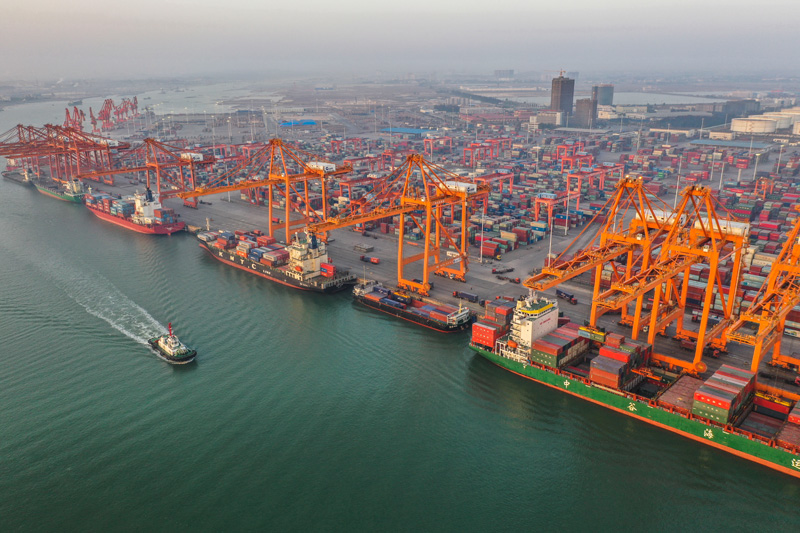

Written by Guan Qiuyun / Translated by Xie Zongming
Guangxi’s coastline stretches for 1,628.59 kilometers, making it the largest gateway to the ocean in Southwestern China. In the past, the coast of Beibu Gulf consisted only of small fishing villages and endless mudflats. The region had long been a coast without a port. Nowadays, the Beibu Gulf Port that consists of the 3 ports in Qinzhou, Beihai, and Fangchenggang is filled with all kinds of ships, becoming a leading port that is key to Guangxi’s master plan for reform, innovation, and development. Furthermore, the port is becoming an international gateway port and a strategic pivot of development for Western and Central-Southern China.
In 2021, the Beibu Gulf Port Group strengthens the consensus with related departments and seizes opportunities to lay stress on Beibu Gulf Port’s capacity building, accelerate the infrastructure upgrade, optimize the port service, actively promote the intelligent port building, facilitate the corridor function, and plan for the port’s future development. Now, a promising list of accomplishments and a new master plan are revealed.
Development of infrastructure and facilitation of port capacity
In February 2021, the Guidelines on Developing Comprehensive National Transport Network positioned Beibu Gulf Port as an international hub port and the construction of which has been listed in the Outline of the 14th Five-Year Plan. A new chapter of Beibu Gulf Port’s development is unveiled.
As the most basic part of port construction, Beibu Gulf Port’s infrastructure development has been accelerated with the help of favorable policies.
On August 31, 2020, 9# and 10# automatic container berths of South Dalanping Operation Zone of Qinzhou Port started construction, which would be the fifth automatic container port and the first sea-rail combined automatic port. The two berths can handle the ULCV, the largest class of container ships in the world, breaking the limit of Beibu Gulf Port in establishing ocean routes due to the lack of infrastructure.

On September 22, workers at the construction site of the Central Container Yard of Fangchenggang Yuwan Port Area were busy with their jobs. It is one of the important projects of the Beibu Gulf Port Intelligent System Construction, which aims to create smart ports, smart ships, and smart routes. The completion of this project will further enhance Fangchenggang Port’s position as the hub port for bulk cargoes and reach the standard of a smart port, which aims to be convenient, cost-effective, green, intelligent, and safe.
Meanwhile, a batch of other key projects has witnessed solid accomplishments. For example, the Qinzhou Railway Container Center Station and the dedicated railway line of Tieshan Port in Beihai are ready to carry out the “final kilometer” of sea-rail combined transport, achieving the full coverage of railways to major port areas and the fine connection of sea-rail combined transport along the New Western Land-Sea Corridor. The Stage I 300m pier construction of the massive berth for bulk cargoes in the Chisha Operation Zone of Fangchenggang Qisha Port Area, the largest bulk cargo terminal in the Beibu Gulf Port was completed, setting the foundation for the next stage. Currently, Guangxi Beibu Gulf Port has built 98 berths for production use that are 10,000-ton-class or above, with a maximum berthing capacity of 300,000 tons. The overall handling capacity of the port is about 360,000,000 tons.
In 2021, the annual container throughput of the Beibu Gulf Port was 6.01 million TEUs, marking a 19% growth. Among China's coastal ports, the Beibu Gulf Port is estimated to be ranked 8th in container throughput and 9th in cargo throughput, for which the Beibu Gulf Port remains one of the fastest-growing ports among the top 10 coastal ports in China.By 2022, Beibu Gulf Port will be open to 200,000-ton-class container ships and 300,000-ton-class bulk ships.

Optimized business environment has attracted industry clusters
Apart from complete infrastructure, a high-quality business environment is also needed. Only by improving the port’s soft power with efficient and detailed services can companies be willing to enter and become prosperous. Companies’ entry will bring vitality to the industry, and thus lay the groundwork for economic development.
Ever since the official launch in December 2019, the Shipping Service Center of the International Gateway Port has gradually attracted many enterprises to enter. Currently, a total of about 120 institutions and companies have entered, whose business covers port management, cargo and shipping agencies, customs clearance, financial insurance, legal consulting, and logistics.
The service center is dedicated to becoming a multi-functional business community that covers port service, shipping administration, and shipping & trade, so as to boost the development of new businesses, such as international transit, transit & consolidation, trade in shipping factors, and international ship registration in Guangxi. The construction of this service center is an epitome of the port’s improvement in business environment.
With documents like the Implementation Plan for Reducing the Logistics Cost of Beibu Gulf Port being issued and carried out, the cost of Beibu Gulf Port’s logistics keeps decreasing and the time cost of imports and exports is reduced. The business environment is constantly improving.
The Qinzhou Port initiated the mutual recognition mechanism between railway container and seaway container to promote convenient trade, investment liberalization, and logistics standardization. The Port also set up overseas depots for empty container return, creating an international intermodal transportation system that ensures the containers have the shortest procedures at the Port. There are also customized services such as the “fixed transportation fee” and “one contract” models. For international trade, the port set multi-purpose counters for all the procedures and the formalities like customs recording and vessels’ entry and leave can be done online, which are similar to other advanced ports in China. The port also introduced fee reduction policies such as exemption of truck loading and unloading fees and extension of the free demurrage period. Beibu Gulf Port strengthens the coordination of all aspects of port production, adopts spot coordination, optimizes vessels scheduling, increases the quarantine and navigation quality, and facilitates joint law enforcement to solve the congestion problem and ensure the rapid growth of container throughput in Beibu Gulf Port.
By the end of 2021, the overall time cost of customs clearance in the port is among the best in China. The major service of the multi-purpose counter has a utility ratio of 100%. The transportation fee of some foreign trade routes is reduced to US$ 100 from US$ 300 per TEU. The overall logistics cost of the containers shipped from Beibu Gulf Port along the Western Land-Sea Corridor is reduced from RMB 8,000 to 5,000 yuan.
Apart from these, the Beibu Gulf Port Group also embraces cooperation with partners to attract more quality projects. Through the enhancement of the cooperation with ASEAN countries along the Belt and Road, such as Malaysia, Brunei, and Thailand, the “Port-Industry Chain-Industrial Park” coordinative development shows great vitality. The Malaysia-China Kuantan Industrial Park has attracted an investment project of RMB 17.5 billion yuan through this kind of coordination. By attracting investment and establishing a joint venture platform for the port’s construction and operation, a batch of high-growth enterprises are introduced, such as COSCO, PSA, HKC Electronic, Shanghai Huayi, Guangxi Steel, JD, and Huawei, creating strong industry cooperation of leading enterprises in port, shipping, coastal industries, and railway. In addition, the modern coastal industries cluster, which mainly includes steel, non-ferrous metals, and oil & foodstuff, begins to take shape in Fangchenggang and a series of high-value projects of Liuzhou Steel and Shenglong Cold-Roll Steel also start construction here.

Weaving a thicker ship and train route network
On September 8, the Lintan of Swire Qinzhou, a ship loaded with plywood for export, departed from the Legou Operation Section of Qinzhou Port to the Port of Tilbury in the UK, marking the official opening of “Qinzhou-Europe” shipping route for general cargoes, which will further promote Qinzhou to become an important distribution center for importing and exporting wood products in China.
Lintan is just one of the ships along this ocean line. The Beibu Gulf Port has opened 12 new routes in 2021, which is the port's largest route expansion in record and 9 of which are for foreign trade. Currently, the port has 64 routes in operation, 37 of which are for foreign trade and the other are domestic lines, connecting to more than 200 ports in more than 100 countries and regions.
The coordination of land and sea operations has a multiplier effect. Currently, a total of 5 sea-rail combined routes have been put into regular operation, heading to Chongqing, Sichuan, Guizhou, and so on. The number of containers shipped through such routes reached 112,000 TEUs. The sea-rail combined transport volume reached 230,000 TEUs, surpassing the annual goal of 200,000 and marking a 105% year-on-year growth. In 2021, the number of sea-rail combined freight trains along the New Western Land-Sea Corridor reached 6117, maintaining a fast 33% growth.
This is our plan for the following 5 years
On November 25, the 12th CPC Guangxi Congress was held in Nanning. Congress put forward the plan for Beibu Gulf Port’s future construction. In the next 5 years, the New Western Land-Sea Corridor is expected to have a larger tractive effect and the construction of the Beibu Gulf International Gateway Port should be completed in general.
Towards this new course and goal, the Beibu Gulf Port Group started its new endeavor.
“In the next 5 years, the Beibu Gulf Port will invest RMB 67.6 billion yuan to the port infrastructure, about 5 times more than that of the 13th Five-Year Plan period. The focus will be on the construction of the 300,000-ton-class deep water berth and other large and specialized port construction, such as the 200,000-ton-class automatic container ports. The number of berths is expected to increase from 90 in 2020 to 120 by the end of the 14th Five-Year Plan period. Also, the handling capacity is expected to increase by 200 million tons with 5.4 million TEUs of new containers added to the port.” Talking about these future goals, Li Yanqiang, Chairman of Beibu Gulf Port Group, said during an interview that the scale of construction is equivalent to building a second Beibu Gulf Port.
However, the enhancement in infrastructure is only the groundwork, which is only the “gate” part of this gateway port. The “way” part, the routes, is waiting to be optimized. Also, there are still potential improvements in the transport network and port services. To be specific, the future construction could be done in 6 aspects:
The first is the development of sea routes, especially the ones to ASEAN. The port should also develop routes to Africa and South America while keep expanding the ocean routes to North America, Europe, and West Asia. By the end of the 14th Five-Year Plan period, there should be more than 100 container routes, including more than 65 foreign trade routes, so as to better serve the development in Western and Central-South China.
The second is to promote the construction of intermodal transport, creating a pattern for river-sea intermodal transport. The port will actively aid the construction of the Pingtang-Luwu Canal, strengthening the connectivity with the Xijiang River Channel. The group should promote the construction of the China-ASEAN intermodal transport union and enhance the exchanges and cooperation with ASEAN port cities.
The third is to keep implementing the charge reduction and service improvement program to increase the efficiency of the port, build a digitalized benchmark international gateway port, and endeavor to become one of the top ports in the world.
The fourth is to keep developing the infrastructure along the Xijiang River Channel in the 14th Five-Year Plan period, enhance the strategic cooperation with cities along the river, further develop the capacity of the inland ports, and comprehensively promote the upgrade of inland ports’ services.
The fifth is to successively invest RMB 3.8 billion yuan to promote the green growth of the port, vigorously promote the construction of the green port, green enterprises, green logistics, and green routes, making a new image of “garden gateway”.
The sixth is to utilize the harbor resource advantages of the sea, port, and rivers, explore the seaside and riverside water sports and tourism projects, initiate the Phase I business and tourism investment attraction, and strive to achieve a tourist throughput of 200,000 person/time by 2025, contributing to the development of Guangxi’s cruise tourism.
The future seems promising. When the Pingtang-Luwu Canal is open, the New Western Land-Sea Corridor will be free of congestion. As the Beibu Gulf Port ventures to the deep blue and become an international gateway and the strategic pivot for the development of Southwestern and Central-South China, the leap development of Guangxi will no longer be a distant dream.
桂ICP备14000177号 Copyright@2006-2013 Guangxi China-ASEAN Panorama Magazine Agency Co., Ltd. All Rights Reserved